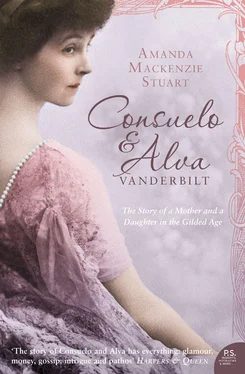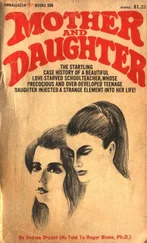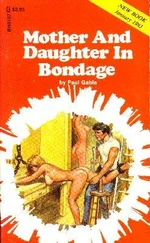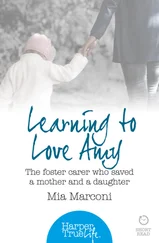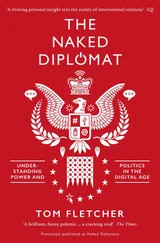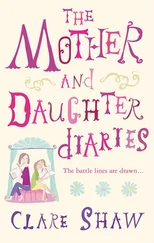On Wednesday 13 March, Alva departed for Europe with Consuelo and Harold, seen off by William Gilmour. The New York Tribune reported that Alva travelled in her usual style with five maids, one man servant and seventy pieces of luggage.
By now, Alva had another compelling reason for sailing to Europe. Preoccupied by her divorce, she had failed to take seriously Consuelo’s growing attachment to a man of thirty-three, which was threatening to undermine her plan to place her daughter in an aristocratic setting. It is impossible that Alva failed to notice the warmth between Consuelo and her American admirer since the indefatigable World had picked up the scent as early as the middle of February that year. On Valentine’s Day, it chose to run the story as a romantic tale of shattered hopes: ‘A young man, bearing an old family first name, prefixed with a prominent Boston family surname, has been all devotion to Miss Consuelo Vanderbilt and she apparently was most happy in his attentions. This joyousness must now be relegated to the saddest of “might have beens”.’ 84 Two days later the same paper explicitly linked Consuelo and the Duke of Marlborough asking: ‘Is she to be a Duchess? It is quite generally recognised that the Duke must marry money if he is to keep up Blenheim. His income is only £8,000 ($40,000) a year and Blenheim costs £14,000 ($370,000) a year.’ 85
The young man who had been all devotion to Consuelo was Winthrop Rutherfurd, son of the eminently respectable Mr and Mrs Lewis Rutherfurd, a New England family of impeccable pedigree (Lewis Rutherfurd was one of the earliest Patriarchs in 1872). Through his mother, Winthrop Rutherfurd was a direct descendant of Peter Stuyvesant, colonial governor of New York, and John Winthrop, the first governor of Massachusetts. ‘Winty’ Rutherfurd was tall and famously good-looking. Though trained as a lawyer, he spent much of his youth playing polo and golf, for which he had something of a reputation. He was a member of the elite Newport Golf Club and has been described as suitable for Consuelo in every way.
As far as Alva was concerned, however, he was not suitable at all. The first problem was that he simply represented the wrong marital path. In America in the 1890s, there were two routes to dynastic marriage open to the new phenomenon, the American heiress. One was to marry into the network of American families enriched by industrial capitalism, further consolidating vast fortunes, creating an aristocracy of money but effectively embracing the ‘new’. The other was to marry into one of the European aristocracies, depleting the industrial fortune but ennobling the American family through association with nobility and centuries of tradition, elegance and culture. 86 This trend had been started in Alva’s generation by Jennie Jerome, who married Lord Randolph Churchill and by Consuelo Yznaga, though as it happened neither of them had huge dowries. By 1895, the European route to aristocratising one’s family had become highly competitive. That year alone there were nine marriages between heiresses and English aristocrats ** while Anna Gould’s marriage to Frenchman Count Boni de Castellane set new standards for lavish New York weddings. By 1914 commentators calculated that over 500 American fortunes had been transferred to Europe through this route. 87 Alva, always ambivalent about the ‘crude’ and ‘unfinished’ nature of American life, embittered by the power structures of American society, drawn to those parts of European history where aristocratic marriages were arranged as a matter of course and a great admirer of British aristocracy was, of course, determined that it would be the European and not the American route for Consuelo.
A further problem with Winthrop Rutherfurd, however, was that he was far too close – and far too similar – to William K. Vanderbilt, the ‘weak nonentity’ whom she had just divorced. According to Cornelius Vanderbilt Jr, ‘the Rutherfurds lived well, dressed expensively, and did little else’, though Winthrop’s father, Lewis Rutherfurd, was a distinguished astronomer who took some early photographs of the surface of the moon. As far as Alva was concerned, Winthrop Rutherfurd was a fine example of the new breed of useless male now emerging, like her ex-husband, from three generations of plutocratic wealth. Alva also suspected him of being a gold-digger. American society had evolved to a point where it was impossible to participate without being very rich. Consuelo’s dowry was a clear temptation to a young man from a good family with social ambitions but without great wealth. Alva, of course, took the view that almost all rich American men were serial adulterers who left the business of keeping up respectable appearance to their wives, while they romped like young colts in ‘the world-wide field’. 88 In Consuelo’s case there was a real danger that she would facilitate ‘romping’ by financing it. Alva always maintained that her divorce had no effect on her children’s lives. In reality, the bitterness and cynicism engendered by William K.’s philandering profoundly coloured her plans for Consuelo’s future.
For the moment, however, she dealt with her daughter’s first love badly, in a manner guaranteed to encourage romance rather than stifle it. According to Consuelo, her first line of attack was contempt, ‘reserving special darts for [the] older man who by his outstanding looks, his distinction and his charm had gained a marked ascendancy in my affections’. 89 Winty’s response was to propose, and when the proposal came, it would not have been out of place in an Edith Wharton novel. It took place on Consuelo’s eighteenth birthday on 2 March 1895, a few days before the finalisation of the Vanderbilt divorce. First, he sent her an American Beauty rose, her favourite. Later, he joined Consuelo, a group of other young people, and Alva, on a cycling expedition along Riverside Drive. ‘My Rosenkavalier and I managed to outdistance the rest. It was a most hurried proposal, for my mother and the others were not far behind; as they strained to reach us he pressed me to agree to a secret engagement, for I was leaving for Europe the next day. He added that he would follow me, but that I must not tell my mother since she would most certainly withhold her consent to our engagement. On my return to America we might plan an elopement.’ 90
Consuelo was not, in fact, due to leave for Europe for another fortnight. But there were to be no further meetings with Winty. A few days after Alva and Consuelo set sail for Paris, several newspapers also noted the departure for Europe of Winthrop Rutherfurd. If he hoped to see Consuelo he was to be disappointed. Alva regarded her daughter’s glow of happiness with dark suspicion and did everything in her power to prevent a meeting. ‘She laid her plans with forethought and skill, and during the five months of our stay in Europe I never laid eyes on Mr X, nor did I hear from him. Later I learned that he had followed us to Paris but had been refused admittance when he called. His letters had been confiscated; my own, though they were few, no doubt suffered the same fate.’ 91 The happiness of the previous summer in Paris was a distant memory. Consuelo tried on new clothes ‘like an automaton.’ 92 Alva was intensely irritated by her daughter’s air of adolescent ‘martyrdom’, and her complaints about it only served to deepen Consuelo’s misery.
Alva later argued vigorously that she had only had her daughter’s interests at heart in keeping her from Rutherfurd in this way. It should not be overlooked that in this period immediately after her divorce, Consuelo’s interests were closely bound up with her own. Alva wished to marry Oliver Belmont. She did not, however, wish to abandon her position as a leader of society once she remarried, and thus retreat from the only theatre of life that was open to her. However high-minded Alva’s reasons may have been for saving her daughter from life with an American plutocrat, Consuelo’s marriage to Winthrop Rutherfurd would have done little to bolster Alva’s position in America, however popular he might have been at Newport Golf Club. The Duke of Marlborough was another matter entirely. Consuelo later maintained that Alva ordered her wedding dress in Paris that spring, so sure was she about the successful conclusion of her plans. There is no evidence for this; but Alva certainly bought hundreds of expensive ‘favors’ – small presents – for a ball, as she now planned what would become a decisive manoeuvre.
Читать дальше
